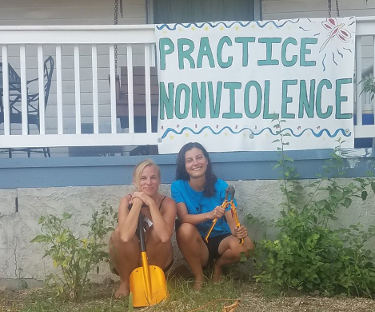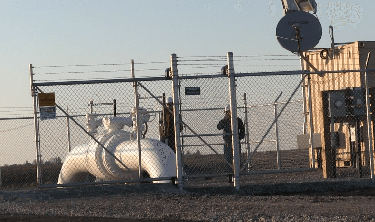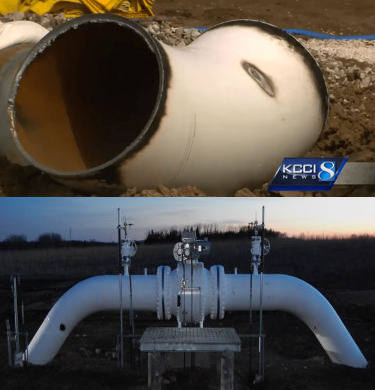Ruby Montoya & Jessica Reznicek: DAPL Ecosaboteurs
“We went to these places with knowledge self-garnered within a matter of weeks and were effectively halting construction for weeks on end just via one fire or one valve piercing.” — Jessica Reznicek
History of Dakota Access Pipeline Ecosabotage
Environmentalists closely followed the 2016 Standing Rock protest against DAPL, but an alternate approach to resistance—ecosabotage—received much less attention. We know of the following efforts against construction:
| When | Where | What |
|---|---|---|
| July 2016 | New Sharon, IA | Construction equipment burned at three sites |
| October 2016 | Reasnor, IA | Construction equipment burned |
| November 2016 | Buena Vista County, IA | Construction equipment burned |
| March 2017 | Multiple locations, IA and SD | Holes burned through pipeline at shut-off valves |
| April 2017 | Multiple locations, IA | Holes burned through pipeline at shut-off valves; electrical units and heavy equipment burned |
| May 2017 | Wapello County, IA | Aborted attempt to burn hole through pipeline at shut-off valve |
Ruby and Jessica’s Journey
We don’t know who carried out the early arsons, but in July 2017, Ruby Montoya and Jessica Reznicek publicly took credit for the string of actions beginning in November. Catholic Workers devoted to nonviolence, they oppose DAPL and all fossil fuel infrastructure as both embodiments and accelerants of violence. They arrived at radicalization in the usual way, having exhausted those tactics condoned by the system precisely because they’re ineffective—attending hearings, collecting signatures, and engaging in rallies, boycotts, and hunger strikes. Moving to civil disobedience, they got a taste of success at Mississippi Stand, with lock downs sometimes halting construction for hours at a time.
They knew they needed to do more, so brainstormed ways to permanently decommission equipment. With no experience committing sabotage, they settled on arson as a simple tactic for their first action. They successfully burned six pieces of heavy machinery by igniting incendiary devices of gasoline, motor oil, and rags placed in coffee canisters.
They then decided they could most effectively set back completion by damaging pipe already in the ground, forcing the company to dig up and replace section after section. They researched how to pierce steel, settling on oxygen-acetylene torches to cut exposed pipe at aboveground shut-off valves. After gathering supplies, they pierced valves up and down the pipeline from March to May 2017, reverting to arson when they temporarily ran out of oxy-acetylene tanks.
Notably, they had no specialized knowledge when they began their ecosabotage, yet refined an effective seven minute “hit and run” action used at site after site, often without advance planning. Jessica described much of their work as “sloppy,” and they wrote in their press release:
In our particular circumstances, we learned that scouting often hindered our ability to act in windows of opportunity. So, we went with our torches and protective gear on, and found numerous sites, feeling out the “vibe” of each situation, and deciding to act then and there, often in broad daylight.
In May, upon discovering flowing oil while attempting another piercing, they ended their campaign. The pipeline began commercial operation in June.
Strategy
Jessica and Ruby employed a strategy of attrition, hoping their actions would help wear down pipeline owner Energy Transfer Partners (ETP) and its investors to force abandonment of the project. Jessica stated in an interview, “We need to delay construction not just for days, but for weeks and months for the ultimate purpose of shutting this pipeline down and having investors pull out.”
Unfortunately, it’s very difficult to stop a huge industrial project via attrition. In their press release, Ruby and Jessica asserted that “every action is a thorn in their side”—but even hundreds of thorns are unlikely to bring down a giant. The dozen or more known acts of sabotage and arson inflicted about six million dollars in damages. That’s less than one sixth of one percent of the $3.78 billion pipeline budget—amounting to a rounding error, and likely reimbursed by insurance. When pricking major industrial infrastructure, thorns splinter and their wielders grow exhausted long before they can win victory.
Material effectiveness
Attrition failed to stop the Dakota Access Pipeline, but a less binary measurement of success is for how long it delayed completion.
The #NoDAPL campaign, centered on Standing Rock, delayed pipeline completion by at least two, perhaps even three months—mostly because the movement’s visibility pressured the Obama administration to temporarily suspend construction. One month after the Trump administration permitted resumption, ETP had drilled under the Missouri River and expected oil to flow by March 22. Ruby and Jessica began their campaign in mid-March, and oil didn’t actually flow until mid-May, with commercial operation delayed until June 1st. Jessica’s claim in their Democracy Now interview seems credible: “We halted construction up and down the line for several weeks, turning into months.”
In terms of material impact, Ruby and Jessica’s ecosabotage was 1000 times more efficient than the aboveground campaigns. At least 15,000 person-months and $20 million poured into Standing Rock and #NoDAPL, setting back pipeline completion three months at most. Ruby and Jessica, with a total investment of 10 person months and probably a few thousand dollars (oxy-acetylene torch kits cost about $400), delayed it a further two months by employing initiative and surprise.
Return on investment: barrels of oil stopped per person month, and barrels stopped per dollar
Hover for a few seconds over underlined headers for explanations
| Who | Target | Tactic | Barrels stopped | Person months | BBLS/p-m | Money | BBLS/$ |
|---|---|---|---|---|---|---|---|
| Valve Turners | Tar sands pipelines | Civil disobedience | .77 million | ~35 | 21,900 | $12-$14,000 | 58 |
| #NoDAPL | DAPL | Civil disobedience | 45 million | > 15,000 | < 3000 | > $20 million | < 2.25 |
| Ruby & Jessica | DAPL | Ecosabotage | 30 million | 10 | 3,000,000 | ~$3000 | 10,000 |
Read our comparison of these campaigns: Pipeline Activism and Principles of Strategy
Jessica speculated that “If Ruby and I had had a crew that had doubled or tripled or quadrupled our numbers, we really could have stopped this thing […] just via actions like we did.” We can’t know for sure whether that’s true; with the pipeline so close to bringing in millions of dollars per month in operational revenue, extra security to attempt to thwart sabotage would have been a minor expense. Nor is safely forming an underground crew trivial; screening, recruiting, and organizing compartmentalized cells while minimizing risk takes careful planning and execution.
But perhaps it’s true that larger numbers, or escalation of tactics, could have stopped DAPL. Ruby and Jessica ceased action once they discovered oil in the pipeline. They might instead have decided the risk of small, localized spills was reasonable compared to the certainty of 500,000 barrels of oil driving global pollution and destruction and burdening the atmosphere with 175,000 tons of CO2 every single day. Though using oxy-acetylene torches on a pipeline with oil would literally have blown up in their faces, perhaps they could have used a different tactic from a safe distance. Perhaps additional direct actionists would have joined them. Perhaps together they could have permanently disabled the pipeline, joining resisters in the Niger Delta as truly successful environmental activists.
It’s a beautiful vision. Ruby and Jessica came forward to inspire action, so perhaps this hypothesis will be tested on the Dakota Access Pipeline, and on others. It would only take a handful of people.
Security Culture
Ruby, new to the environmental activist scene, found that people immediately shut down conversation when she speculated about directly halting construction. “Can’t we just stop the machine—break it?” Many people assumed she was a cop; Jessica was warned not to work with her.
Infiltrators have targeted the environmental movement for years. Caution is necessary, but fear based, knee-jerk reaction to any mention of ecosabotage crosses into paranoia. Security culture should facilitate success. Not getting arrested is an important part of being effective, but so is discussing what tactics might actually work.
Most of the activists protesting and engaging in civil disobedience against DAPL risked little by brainstorming ways to disable machinery or the pipeline. The most substantial risk fell on Ruby and Jessica, since they went on to commit sabotage. Ruby and her comrades got security culture backwards; ideally Ruby would not have expressed any interest in underground tactics, while those limiting themselves to aboveground action would have brainstormed freely. The more people discussing and advocating underground action, the more difficult it is for agents of the status quo to pick out those transitioning from aboveground to underground work.
Ruby and Jessica’s gradual process of radicalization increased their vulnerability. By engaging in a full range of aboveground efforts, escalating from letter writing to hunger strikes to civil disobedience, they exposed themselves as committed pipeline opponents. As a result, by May 4, security firm TigerSwan had identified Ruby and Jessica as the most likely suspects for the valve piercings. Had the pair not proactively ended their campaign shortly after, it’s possible they would eventually have been caught and severely prosecuted.
Ideally, Ruby and Jessica would have observed the failure of aboveground actions carried out by others, then jumped straight to underground tactics themselves. Accepted methods for opposing industrial projects, including most civil disobedience, funnel us into a maze of constrained choices. Our actions are predictable and always lead to dead ends, while surveillance cameras track our movements and capture our identities. With the world in crisis, we don’t have time for every potential underground activist to explore the entire maze before climbing over the walls and acting free of the system’s constraints. Further, underground actionists minimize personal risk by never entering the maze and being identified in the first place.
Nonetheless, we should celebrate the admission of a former TigerSwan operative, “We’d been trying to track them for a long time. They eluded us. Those girls were successful.”1
Since the Press Conference
In the weeks following their public statement, Jessica and Ruby gave multiple interviews and presentations. The FBI raided their home in early August 2017, but no federal charges were ever brought against them. At the end of September, they left Des Moines and went into hiding.
In August 2018, ETP added the pair to a SLAPP2 lawsuit they’d filed a year earlier against Greenpeace, Mississippi Stand, and other activists. Soon after, Ruby and Jessica returned to Des Moines following an apparently difficult year. In February 2019, a federal judge dismissed ETP’s “paranoid, farcical and manufactured conspiracy theory3.” Ruby subsequently went home to her family and began teaching at a Waldorf school. Jessica started work with Meta Peace Team and spent time in a monastery.
In October 2019, both women were arrested and charged for the ecosabotage. In January 2021, Jessica and Ruby each pleaded guilty to one charge of “Conspiracy to Damage an Energy Facility”, with a maximum penalty of 20 years in prison and/or a $250,000 fine.
More about Ruby and Jessica
- Our comparison of the Valve Turners, #NoDAPL, and Ruby and Jessica: Pipeline Activism and Principles of Strategy
- Ruby and Jessica's press release
- The Intercept: “TigerSwan Responded to Pipeline Vandalism by Launching Multistate Dragnet,” touching on TigerSwan’s suspicion of Ruby & Jessica
- The Intercept: “The Infiltrator,” with several mentions of Ruby and Jessica
- TigerSwan Situation Reports mentioning Jessica
- Interview by Jennifer Murnan and Max Wilbert
- Democracy Now interview by Amy Goodman
- July 2018 follow up on the absence of federal charges
- Miscellaneous videos: press conference, interviews, and presentations
- Mississippi Stand, chronicling attempts to stop DAPL via aboveground tactics (via archive.org)
- Story on November 2016 construction equipment arson
- Brief description of March 2017 pipeline piercings
-
The Intercept: “The Infiltrator,” second to last paragraph. The piece is worth reading in full. ↩︎
-
SLAPP = Strategic Lawsuit Against Public Participation. Learn more at the Public Participation Project. ↩︎
-
As characterized by Civil Liberties Defense Center lawyer Lauren Regan, another environmental heroine. ↩︎
Consider supporting our work by joining our mailing list below, sharing & "liking" this page, and following us on social media. You may freely republish this Creative Commons licensed article with attribution and a link to the original.



